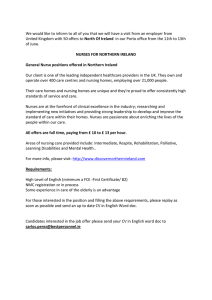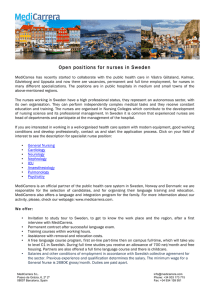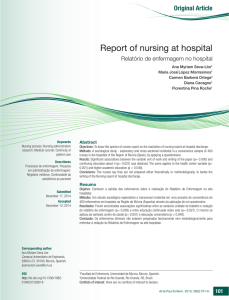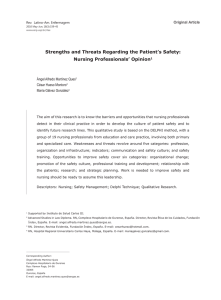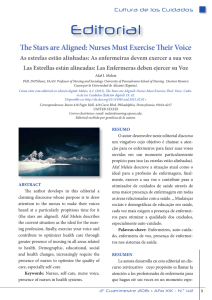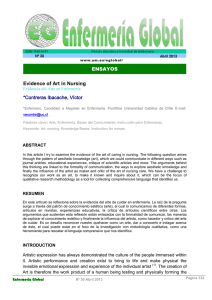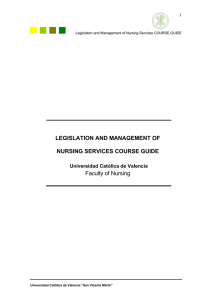Development of a functional model of nursing care in cancer
Anuncio
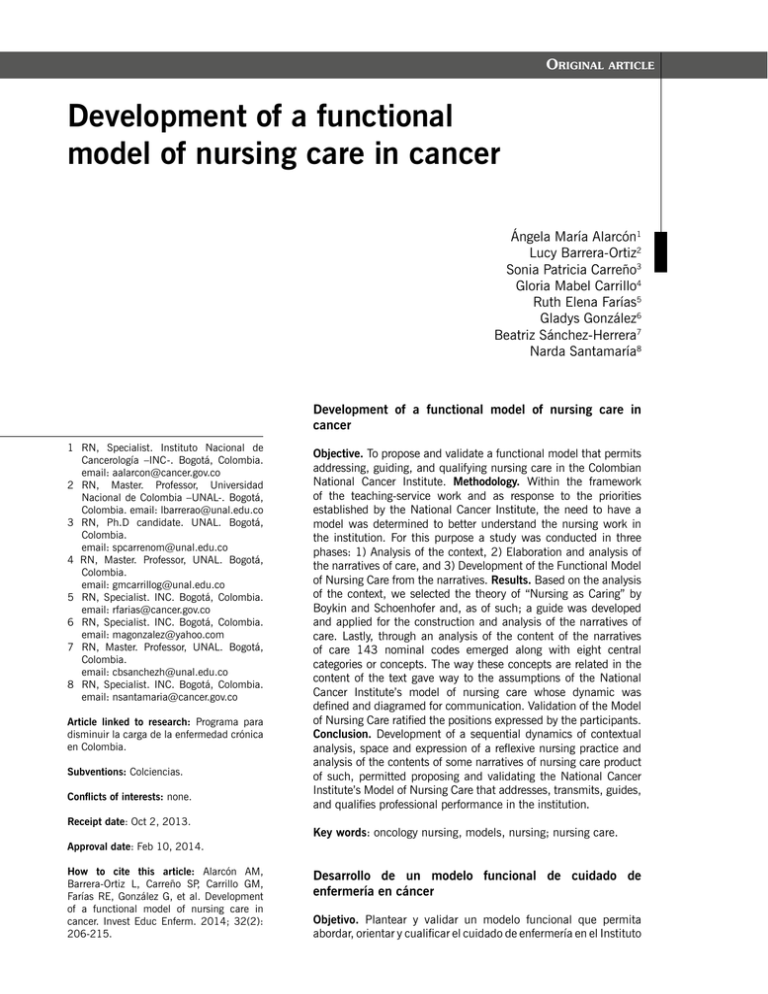
Original article Development of a functional model of nursing care in cancer Ángela María Alarcón1 Lucy Barrera-Ortiz2 Sonia Patricia Carreño3 Gloria Mabel Carrillo4 Ruth Elena Farías5 Gladys González6 Beatriz Sánchez-Herrera7 Narda Santamaría8 Development of a functional model of nursing care in cancer 1 RN, Specialist. Instituto Nacional de Cancerología –INC-. Bogotá, Colombia. email: aalarcon@cancer.gov.co 2RN, Master. Professor, Universidad Nacional de Colombia –UNAL-. Bogotá, Colombia. email: lbarrerao@unal.edu.co 3 RN, Ph.D candidate. UNAL. Bogotá, Colombia. email: spcarrenom@unal.edu.co 4 RN, Master. Professor, UNAL. Bogotá, Colombia. email: gmcarrillog@unal.edu.co 5 RN, Specialist. INC. Bogotá, Colombia. email: rfarias@cancer.gov.co 6 RN, Specialist. INC. Bogotá, Colombia. email: magonzalez@yahoo.com 7 RN, Master. Professor, UNAL. Bogotá, Colombia. email: cbsanchezh@unal.edu.co 8 RN, Specialist. INC. Bogotá, Colombia. email: nsantamaria@cancer.gov.co Article linked to research: Programa para disminuir la carga de la enfermedad crónica en Colombia. Subventions: Colciencias. Conflicts of interests: none. Receipt date: Oct 2, 2013. Objective. To propose and validate a functional model that permits addressing, guiding, and qualifying nursing care in the Colombian National Cancer Institute. Methodology. Within the framework of the teaching-service work and as response to the priorities established by the National Cancer Institute, the need to have a model was determined to better understand the nursing work in the institution. For this purpose a study was conducted in three phases: 1) Analysis of the context, 2) Elaboration and analysis of the narratives of care, and 3) Development of the Functional Model of Nursing Care from the narratives. Results. Based on the analysis of the context, we selected the theory of “Nursing as Caring” by Boykin and Schoenhofer and, as of such; a guide was developed and applied for the construction and analysis of the narratives of care. Lastly, through an analysis of the content of the narratives of care 143 nominal codes emerged along with eight central categories or concepts. The way these concepts are related in the content of the text gave way to the assumptions of the National Cancer Institute’s model of nursing care whose dynamic was defined and diagramed for communication. Validation of the Model of Nursing Care ratified the positions expressed by the participants. Conclusion. Development of a sequential dynamics of contextual analysis, space and expression of a reflexive nursing practice and analysis of the contents of some narratives of nursing care product of such, permitted proposing and validating the National Cancer Institute’s Model of Nursing Care that addresses, transmits, guides, and qualifies professional performance in the institution. Key words: oncology nursing, models, nursing; nursing care. Approval date: Feb 10, 2014. How to cite this article: Alarcón AM, Barrera-Ortiz L, Carreño SP, Carrillo GM, Farías RE, González G, et al. Development of a functional model of nursing care in cancer. Invest Educ Enferm. 2014; 32(2): 206 • Invest Educ Enferm. 2013;31(3) 206-215. Desarrollo de un modelo funcional de cuidado de enfermería en cáncer Objetivo. Plantear y validar un modelo funcional que permita abordar, orientar y cualificar el cuidado de enfermería en el Instituto Development of a functional model of nursing care in cancer Nacional de Cancerología de Colombia (INC). Metodología. En el marco del trabajo de docencia-servicio y como respuesta a las prioridades establecidas por el INC, se determinó la necesidad de contar con un modelo para comprender mejor el quehacer de enfermería en la institución. Para ello se adelantó un estudio en tres fases: 1) Análisis del contexto, 2) Elaboración y análisis de las narrativas de cuidado y 3) Desarrollo del Modelo funcional de Cuidado de Enfermería a partir de las narrativas. Resultados. Con base en el análisis del contexto se seleccionó la teoría de “Enfermería como Cuidado” de Boykin y Shoenhofer; a partir de esta se desarrolló y aplicó una guía para la construcción y análisis de las narrativas de cuidado. Por último, mediante un análisis de contenido de las narrativas de cuidado emergieron 143 códigos nominales y ocho categorías o conceptos centrales. La forma como estos conceptos se relacionan en el contenido del texto dieron paso a los supuestos del modelo de cuidado de enfermería del INC cuya dinámica fue definida y graficada para ser comunicada. La validación del Modelo de cuidado de enfermería ratificó los planteamientos expresados por los participantes. Conclusión. El desarrollo de una dinámica secuencial de análisis contextual, espacio y expresión de una práctica reflexiva de enfermería y el análisis de contenido de unas narrativas de cuidado de enfermería producto de la misma, permitieron plantear y validar el Modelo de Cuidado de Enfermería del INC que aborda, transmite, orienta y cualifica el desempeño profesional en la institución. Palabras clave: enfermería oncológica; modelos de enfermería; cuidados de enfermería. Desenvolvimento de um modelo funcional de cuidado de enfermagem em câncer Objetivo. Propor e validar um modelo funcional que permita abordar, orientar e qualificar o cuidado de enfermagem no Instituto Nacional de Cancerologia de Colômbia (INC). Metodologia. No marco do trabalho de docência-serviço e como resposta às prioridades estabelecidas pelo INC, determinou-se a necessidade de contar com um modelo para compreender melhor o afazer de enfermagem na instituição. Para isso se adiantou um estudo em três fases: 1) Análise do contexto, 2) Elaboração e análise das narrativas de cuidado e 3) Desenvolvimento do Modelo funcional de Cuidado de Enfermagem a partir das narrativas. Resultados. Com base na análise do contexto se selecionou a teoria de “Enfermagem como Cuidado” de Boykin e Shoenhofer e a partir desta, desenvolveu-se e aplicou uma guia para a construção e análise das narrativas de cuidado. Por último, mediante uma análise de conteúdo das narrativas de cuidado emergiram 143 códigos nominais e 8 categorias ou conceitos centrais. A forma como estes conceitos se relacionam no conteúdo do texto deram passo aos supostos do modelo de cuidado de enfermagem do INC cuja dinâmica foi definida e gravada para ser comunicada. A validação do Modelo de cuidado de enfermagem ratificou as propostas expressadas pelos participantes. Conclusão. O desenvolvimento de uma dinâmica sequencial de análise contextual, espaço e expressão de uma prática reflexiva de enfermagem e a análise de conteúdo de umas narrativas de cuidado de enfermagem produto da mesma, permitiram propor e validar o Modelo de Cuidado de Enfermagem do INC que aborda, transmite, orienta e qualifica o desempenho profissional na instituição. Palavras chave: enfermagem oncológica; modelos de enfermagem; cuidados de enfermagem. Introduction Within the framework of the care-giving faculty staff agreement between the National Cancer Institute (INC, for the term in Spanish) and the Faculty of Nursing at Universidad Nacional de Colombia, the “Workshop on Foresight Planning for Nursing” was held in September 2012, which defined the critical elements of the desired scenario at ten years and prioritized them by importance and governance defining the strategies to accomplish them. This foresight reported on the need to define a guiding model of nursing work, which articulated with the institutional project, its vision and mission will permit comprehending and qualifying the practice. Those who participated in said Invest Educ Enferm. 2014;32(2) • 207 Ángela María Alarcón • Lucy Barrera-Ortiz • Sonia Patricia Carreño • Gloria Mabel Carrillo • Ruth Elena Farías • Gladys González • Beatriz Sánchez-Herrera • Narda Santamaría workshop indicated that having a specific model for nursing is related to being able to improve the quality of care, enhance identity, and concentrate actions on the fundamental; having greater costeffectiveness, better levels of user satisfaction, developing interpersonal skills, propitiating continuity in processes, and demonstrating that nursing is indispensable to improve life conditions and care of users. It was also recognized that the consolidation of the model should not generate additional demands on the practice or compete with it; on the contrary, it would be a voluntary invitation that would respond to patterns of logic, permit managing simple and comprehensible language, and that would be fully articulated with the type of nursing practice carried out at the INC. Based on the workshop’s decision, the reflection was begun on nursing as a professional discipline whose growth is linked to the sense its work has, which must be communicated through its theoretical development. Reed and Shearer,1 Wimpenny,2 Meleis3, and Fawcett4 point out that within this theoretical development there are different sources and possibilities of use and reach of the theories generated. The theoretical or conceptual models of nursing, for example, are among those forms that are abstract, communicate and articulate a mental image of a reality of a certain order, of its components and of the existing relationship among them. Sánchez5 describes that a theoretical model of nursing is a set of concepts joined by propositions that lead to verifiable hypotheses on professional work to explain, systematize, and qualify the nursing practice. Development of a theoretical model can be accomplished through deductive or inductive mechanisms and may support progress of the professional discipline inasmuch as it is logical, simple, generalizable, and consistent with other of its advances. However, according to the author, besides the theoretical models, nursing has functional and mental models. The theoretical or conceptual models are those that support the conceptualization, help to organize ideas of nurses, generate professional identity, are articulated with other levels of theory, and guide the definition 208 • Invest Educ Enferm. 2014;32(2) of processes and indicators to help address the nurse’s professional performance; these are not directly applicable to practice and require for such the development of medium-range theories, more applicable to concrete problems and which open the possibility of generating empirical indicators for the practice. The functional models, on their part, are associated to the theoretical models, guide more closely the nursing practice in the clinical field, permit making representations, facilitate action with theoretical framework, support standardization and audit to qualify processes, and generate professional and institutional identity. Lastly, personal or mental models are those constructed through experience; they represent nursing described by nurses, do not generate professional development and cannot be transmitted or standardized. That is, theoretical models are fundamental to enhance the professional discipline, while the functional models are fundamental for the organization of institutional schemes.5 Assuming that by making explicit the conceptual and functional orientation favors the development and qualification of the practice, addressing the proposals generated within the institutional projection and verifying the development possibilities of the professional nursing discipline, this work sought to propose and validate a functional model that under a previously identified conceptual or theoretical model, will permit addressing, guiding, and qualifying nursing care in the National Cancer Institute E.S.E. Methodology This was a descriptive study, with a qualitativetype approach that followed the content-analysis methodology6 to induce the Functional model of care from narratives of nursing care. To generate the model, three phases were fulfilled: the first, analysis of the context; the second, elaboration and analysis of the narratives of care; and, lastly, development of the functional model from the narratives. Development of a functional model of nursing care in cancer Phase 1. Analysis of the context. This stage consisted of the consolidation of a group of eight experts incorporating four professionals with clinical experience of at least five years in the INC in the area of oncological patient care and four with teaching experience in nursing care of chronic patients and who had done their practice in the institution or whose masters or PhD formation in nursing reflects broad experience in the field of epistemology. This group analyzed the institutional context and found within it acceptance of care as the central axis, dominant and unifying of the nursing practice. From such, the group revised several options of theoretical or conceptual models, guiding the nursing practice to define the one that could be best employed in the institutional practice. Phase 2. Elaboration and analysis of the narratives of care. Upon defining the practice’s guiding theoretical approach; a guide was elaborated and validated by part of the group of experts to facilitate the INC nursing professionals to narrate what they considered good care practices. This guide helped to organize the narrative of the practical experience, to refine and understand it. Initially, during the development of the guide each professional was asked to refer to a care experience considered a good practice, seeking that such had left a degree of satisfaction due to their performance and some lesson to become a better caregiver. Based on the experience narrated by each professional, participants were then asked to identify if such fulfilled the criteria to be characterized as “Nursing situation”7 and if so, identify in it the metaparadigm concepts of nursing, knowledge patterns, and the philosophical vision of nursing expressed by their narrative. The interviews of the narratives were recorded and textually transcribed. Participants received the guide developed for this purpose and, based on it, analyzed the written content of their narrative. Both the narrative and the analysis developed by each informant were documented and later revised by the informant. The inclusion criteria for the participants considered their being nursing professionals with at least six months of work in the INC. The study sought to include in the group veteran and young professionals from different schools of formation, shifts, contract modalities, and services, which in all could affect the care experience. Phase 3. Development of the Functional model from the narratives. This third phase consisted in the qualitative analysis process of the content6 of the narratives of what for each participant was a good care practice and which in all permitted generating the INC care model. The saturation criterion was theoretical8 and was reached through the analysis of 10 narratives; however, the authors decided to include the 22 developed that would lead to the construction of the functional model. The texts of the narratives were included in the Atlas-ti qualitative analysis program, under license from Universidad Nacional de Colombia. Initially, from each narrative complete phrases or live codes were taken for analysis based on which the descriptive codes were generated. Thereafter, each of these descriptive codes received one or several denominations characterizing it in conformity with the sense given by each participant within the text. These denominations gave rise to the nominal codes. The nominal codes were grouped through a comparative crosssection analysis, through which it was possible to identify objects, occurrences, actions, or events that share common characteristics, which gave way to the categories constituted as the model’s essential concepts. Afterward, an analysis was performed on how the categories are interrelated, consolidating the model’s assumptions. Upon defining the model’s concepts and assumptions, an analysis of it was structured by following an internal validation exercise to check that complies with the necessary parameters to be considered as such. Lastly, the validation process was conducted of the theoretical approach that emerged from the content of the narratives, which implied again contacting all the participants so Invest Educ Enferm. 2014;32(2) • 209 Ángela María Alarcón • Lucy Barrera-Ortiz • Sonia Patricia Carreño • Gloria Mabel Carrillo • Ruth Elena Farías • Gladys González • Beatriz Sánchez-Herrera • Narda Santamaría they could review it during a meeting scheduled by the directors of the INC nursing area group. With respect to the ethical considerations, the provisions of Resolution 008430 of 1993,9 Legislation 911 of 2004,10 and the International ethical guidelines for biomedical research with human beings11 were kept in mind and the informed consent process was carried out. Results Phase 1. Analysis of the context. From the analysis of the context, the theory of “Nursing as Care” proposed by Anne Boykyn and Savina Shoenhofer12 was defined. The theory of “Nursing as Care” has been classified as a great theory to transform the practice and its central objective is that of knowing and nourishing those who as human beings experience and grow in the care. Under this theory, a Nursing situation is the encounter in which nurses interact with care receptors responding to a calling, respecting their dignity as people and nourishing their capacity as caregivers. Within this encounter that occurs within a particular context particular, nurses gain knowledge and are, in turn, strengthened as caregivers. The narrative of a nursing situation is the way of knowing nursing and the means proposed by the theory for all the ways of researching in nursing.12 It was established that the development of a functional model of nursing care for this institution had to be compatible with said theory. Phase 2. Elaboration and analysis of the narratives of care. The guide was developed by 22 nurses who fulfilled the inclusion criteria. Within this group, labor involvement fluctuated from six months to 35 years; participants’ ages ranged from 23 to 56 years; the study included nurses from emergency services, hospitalization, surgery, hematology, day hospital, outpatient services, and epidemiology. Nurses from the morning, afternoon, and night shifts were incorporated, with and without graduate degree and with full, interim and contractual labor relationship. 210 • Invest Educ Enferm. 2014;32(2) Based on said guide, each was able to refer to his or her narrative of care and verify that it corresponded to a nursing situation. The narratives were reviewed once the interviews were transcribed to guarantee that the corresponded exactly to its original version and from it each nurse identified his or her epistemological and oncological characteristics. Based on each of these narratives and analysis a publication was proposed. Phase 3. Development of the functional model from the narratives. From the 22 narratives of care, 143 nominal codes emerged that in turn gave way to the eight categories. By the narratives referring to what for the professionals was a “good care practice” the transversal analysis reflected that the patterns of all the participants were common, that they were clear on what for them was the meaning of “good care”. Upon analyzing the content of the narratives, it became evident that to the extent that this practice becomes visible, is validated and communicated, it can give rise to a functional model of nursing care for the INC. This is how it was defined that the categories emerging from the care narratives become the model’s central concepts and the interaction of these categories begins to make up its assumptions. The following presents the definition of each of the categories or central concepts: Characteristics of being a nurse. Nurses who provide good care in the INC express their being in assertive and truthful manner, maintain motivation; are curious, proactive and resourceful with respect to their patients and relatives. They lead with fortitude, optimism and valor; they are sensitive and their responsibility reflects not merely vocation, but also a great sense of belonging. These nurses give their best; they have disposition, are patient, persistent and persevering. Characteristics of the nurses’ work. Nurses guide their care with the nursing process based on the fact that it anticipates, has continuity, follows up, reports, propitiates changes, educates patients and their relatives, and supports rehabilitation. Development of a functional model of nursing care in cancer Amid all this, nurses live their experience, increase their expertise and with such enhance the capacity to perform aesthetic activities and morally conduct the practice, providing quality care that is, opportune, with good management and achievement indicators. Through care, nurses are perceived as therapeutic instruments; through their physical contact, they relieve pain, as well as other symptoms endured by their cancer patients. Reciprocity of care. Care experienced at the Institute is two way; it is comprehensive care, caring for life, responding to the call made by patients and their families. It provides companionship, but is also supported by trust. Frequently, nurses generate a bond in which inter-subjectivity and reciprocity are experienced, permitting transactions amid a therapeutic relationship. Within this dynamic where the other is important, adequate communication is generated, along with true listening, interaction with connection, with presence. It is common for this form of care to generate affect, which provides support, understanding, and solidarity, given that empathy is generated among patients, family and nurses. It is also frequent for nurses to advocate for those cared for, which expresses their commitment, loyalty, and respect toward them and, likewise, receive in return. empowers and generates harmony; it goes beyond beneficence. Each care interaction has its own consequences, its added value. Care and spiritual growth, hope, reflection, and transcendence are experienced and felt. As a consequence of that care, nurses recognize themselves, increase their ability for caring on a daily basis, and strengthen their professional motivation when they also feel institutionally or professionally recognized. Care enhances human dignity, privileges patients and family caregivers, permits valuing life. With care, each achievement can be a small motive for happiness, gratitude, satisfaction, and a step that offers greater security. The patient’s conditions. Patients and their families are active subjects whose self-determination is acknowledged, as well as their human needs, and their preferences are respected. Theirs is not an individual situation, patients have or yearn for their family and a family care giver exists that in spite of providing strong support, like themselves, endure great suffering. Comprehensive health. Health in this care experience where healing is not always possible is experienced as wellbeing, as quality of life or comfort. Patients must confront, assume challenges that include adhering to treatments that are sometimes very difficult, although they seek to overcome barriers and care for themselves. Independence is definitive to feel healthy and, as in no other scenario, a profound sense of spirituality appears that joins the being with a higher force and helps them to rethink their relationships with themselves and with the rest. The context of care. The INC is perceived by patients, their families, and professionals as a privileged place both because of its therapeutic objects and because of the level of technical knowledge and continuous training of its staff and which is reflected on humanistic and scientific knowledge and on the teamwork that some perceive as companionship. However, this reality is relative and although many know they require of the institution, some prefer home care, where in spite of not having professionals, they generally have multiple caregivers and a more familiar environment. The INC reflects social commitment with its patients and families, most of which belong to low socioeconomic levels. Within the environment social networks are recognized that support them in their care during their illness process and in some cases until the end of life. The consequences of care. Through reciprocal care institutional values experienced; learning takes place, change is accomplished, along with human development, and undoubtedly mutual growth. It may be stated that care is transforming, which The disease burden. In enduring the experience, generally the onset of the disease has been an unexpected event that often generates limitations, fatigue, impairment, and mutilation of such magnitude that for some patients is like living Invest Educ Enferm. 2014;32(2) • 211 Ángela María Alarcón • Lucy Barrera-Ortiz • Sonia Patricia Carreño • Gloria Mabel Carrillo • Ruth Elena Farías • Gladys González • Beatriz Sánchez-Herrera • Narda Santamaría in death. Both patients and families live in grief, recognize themselves as vulnerable, and manifest their difficulties, suffering, and sorrow and occasional guilt for something that has occurred, some state feeling the burden of the care. The magnitude of the experiences also involves nurses, who upon perceiving the burden are seen vulnerable. 15. The burden permits evaluating the INC and its support networks Assumptions of the INC model de nursing care 19. The cancer experience conception of health Upon defining the categories or concepts, it was sought to examine how these are related within the content of the narratives and therein emerged 35 assumptions that articulate the categories together; the following is their list: 20. The consequences of care ease the disease burden 1. Qualification of human talent favors care 2. With the support of social networks care is possible 22. Patients and families seek healing or wellbeing 3. Care is interdisciplinary 4. Qualified care is part of the environment 5. The environment favors continuous care 6. Institutional and professional recognition gratifies nurses 7. Being and feeling part of the environment generates commitment 8. Health seen in comprehensive manner transforms the environment 9. The environment consequences of care 16. The INC and its support networks take into account patients and their families 17. Patients and families are part of the INC environment 18. The INC and its support networks value life affects the 21. Care benefits patients and their families and impact on nurses becoming better care givers 23. Wellbeing is associated to diminished burden 24. Patients and families feel and express gratitude when they are supported to ease the burden 25. The burden is associated to inner growth 26. Care is guided once recognizing the patient’s and family’s self-determination 27. Care seeks to satisfy human needs 28. Care singles out and seeks to be acquiescent the 29. Care is extended to the family and especially to the care giver 10. Gratitude exists toward the INC and its support networks 30. Care eases the burden of the personal and family experience of having cancer 11. The environment favors the challenges assumed by patients and their families 31. Care is evaluated by the wellbeing and the quality of life it generates 12. Being in the environment generates or supports wellbeing 32. Care accompanies during the challenges endured during the experience of having cancer expresses 13. Within the context, patients and their families are seen comprehensively 14. Patients and their care givers receive aid to ease the burden in the INC 212 • Invest Educ Enferm. 2014;32(2) 33. Care promotes independence 34. The spiritual dimension of care is part of health Development of a functional model of nursing care in cancer 35. The experience of living with someone with cancer or caring for that person is transforming The representation of the care desired at the INC From the analysis of narratives of care or, as denominated by the theory of Nursing as Care, of “Nursing situations” emerged the model’s components, which include the categories and assumptions and together these permit reflecting a unique dynamic of nursing care within the INC. This dynamic is summarized upon indicating that when nurses are aware of the conditions of patients and their families and of the disease burden they endure, they manage to make the difference through care to improve in the patients and families the level of wellbeing. For this, it is indispensable for the nurses’ being and doing to reflect said care. The care sought by the INC is reciprocal care, which generates consequences to favor the patient’s comprehensive health and which in turn permits the nurse’s growth as caregiver. Reflecting this model’s dynamic was the final step to bring it to validation in clear and simple manner. for supporting us with this development that really reflects the strength that can be acquired between teaching and care when there is a common purpose. We have dreamt of doing of our own based on our practice and we see it reflected here; this befits the INC, it is so (P7). The participants revised the inclusion criteria to make sure that in the model suggested the different types of work involvement were embodied along with the generations that share the experience of caring in the INC. No expression was raised in partial or total disagreement with the model proposed. Discussion To validate the model, the patients were again explained how the process was carried out based on the selection of the theory, construction of a work guide with which the narratives and analysis of said narratives are developed through codifying, categorizing, and on the emergence of concepts and assumptions that make up the model. Lastly, the dynamic was shown through the use of the graphic. Based on the theory of Nursing as Care, theoretical medium-range developments have been generated like those proposed by Locsin13,14 or model of machinery technologies; that by Dunphy and Windland15 on the circle of care; that by Guo et al.,16 on nursing education based on MONEC care, and the care denominated as central domain on education in nursing by Touhy and Boykin.17 No theoretical developments of functional care giving models are known from this theory with which the present work may mean a contribution to knowledge. The INC nursing care model emerges from the recognition of the practice that, as indicated by important theorists1-4,12 is the basic source of nursing knowledge. Its sequential development permits evidencing that analysis of the context is fundamental to determine the theory that best responds to the needs, as accomplished in this case by the theory of Nursing as Care. During this validation process, expressions with respect to the result of the model were expressed in positive manner indicating that the theoretical approach reflected the content of the narratives. The following reveal some examples: At last, we are visible; this model brings color to what we have done for a long time and did not know how to communicate… this is very emotional [sobbing]. Participant (P1). It is thus, as you reflect it; this work is like that, thanks (P3). Thank you Stemming from the theory selected, it is again evident that nursing situations are an incalculable source for understanding care.7,18 It is how in each of the experiences narrated, besides identifying the characteristics of a situation, the values of care that reflect the institutional mission are present.19 The model induced from the narratives of nursing situations reflects care as a transforming and guiding condition of the practice. That is, it is without a doubt, as reflected by other authors20-22 Invest Educ Enferm. 2014;32(2) • 213 Ángela María Alarcón • Lucy Barrera-Ortiz • Sonia Patricia Carreño • Gloria Mabel Carrillo • Ruth Elena Farías • Gladys González • Beatriz Sánchez-Herrera • Narda Santamaría that care permits expressing in practice all the forms of knowledge nurses have. Upon classifying the INC nursing care model induced from the narratives of nursing situations, it may be stated that it is a functional model, of humanist orientation, given that its processes help the development of the individual within a positive relationship climate.23 Similar models have been proposed for the nursing practice that privilege care as central, dominant, and unifying axis of such.24 This is an intervention model, given that it permit and guides the direct action of service on a beneficiary group constituted by patients and their families through care in different roles that include, among others, care-giving, educating, and advising. As well as other models, the family is a comprehensive part of oncological care.25,26 From the organizational point of view, the INC nursing model is accepted as institutional, given that it is frameworked within the INC mission and vision and reflects the feelings and work of nursing within this entity. Lastly, it is worth indicating that by it being a useful care model for the service, it must permit monitoring, reflect comprehensiveness, and be representative of the practice; criteria that has been fully fulfilled. It will be necessary, however, to continue the development with measurement indicators that permit permanently qualifying nursing care. Acknowledgments. The authors thank the participating nurses for sharing their marvelous experiences of care through the narratives of “Nursing situations”, the INC Nursing Coordination for its intra-institutional work for the project, and the Group of Care for Chronic Patients and their Families at Universidad Nacional de Colombia, which within the framework of the “Program to Diminish the Burden of CNCD in Colombia” made possible this development. References 1. Reed P, Shearer N. Nursing knowledge and theory innovation: advancing the science of practice. New York: Springer Publishing Company; 2011. 214 • Invest Educ Enferm. 2014;32(2) 2. Wimpenny P. The meaning of models of nursing to practicing nurses. J Adv Nus. 2002; 40(3):346–54. 3. Meleis AI. Theoretical nursing: Development and progress. Fourth ed. Philadelphia: J. B. Lippincott; 2007. 4. Fawcett J. Evaluating Research for Evidence-based Nursing Practice. Philadelphia (PA): FA Davis Company; 2009. 5. Sánchez B. Utilidad de los modelos conceptuales en la práctica de enfermería. El Arte y la Ciencia del Cuidado. Bogotá: Unibiblos; 2002. 6. López E. El análisis de contenido tradicional. En García M, Ibáñez J, Alvira F. El análisis de la realidad social. Métodos y técnicas de investigación. 3rd ed. Madrid: Alianza; 2001. 7. Gómez O, Gutiérrez E. La Situación de Enfermería: fuente y contexto del conocimiento de enfermería. La narrativa como medio para comunicarla. Bogotá: Editorial Universidad Nacional de Colombia; 2011. 8. Arias M, Giraldo C. El rigor científico en la investigación cualitativa. Inv Educ Enferm. 2011; 29(3):500-14. 9. República de Colombia, Ministerio de Salud. Resolución 008430 de 1993 Por la cual se establecen las normas científicas, técnicas y administrativas para la investigación en salud. (4 de octubre de 1993). 10.Congreso de la República de Colombia. Ley 911 de 2004. (octubre 5). Por la cual se dictan disposiciones en materia de responsabilidad deontológica para el ejercicio de la profesión de Enfermería en Colombia; se establece el régimen disciplinario correspondiente y se dictan otras disposiciones. Diario Oficial. Bogotá D.C: No. 45.693, (6 de octubre de 2004). 11.Consejo de Organizaciones Internacionales de las Ciencias Médicas. Pautas éticas internacionales para la investigación biomédica en seres humanos preparadas por el consejo de organizaciones internacionales de las ciencias médicas (CIOMS). Ginebra: CIOMS; 2012. 12.Boykin A, Schoenhofer S. Nursing as caring: a model for transforming practice. Boston: National League for Nursing; 2001. 13.Locsin R. Technological competency as caring in nursing: A model for Practice. Indianapolis Indiana: Development of a functional model of nursing care in cancer Center Nursing Press, Sigma Theta Tau International Honor Society of Nursing; 2005:117-28. 14.Locsin R. Machine Technologies and Caring in Nursing. IMAGE. J Nurs Scholarship. 1995; 27(3):201-3 15. Dunphy LM, Winland JE. The circle of caring: a transformative model of advanced practice in nursing. Clin Escell Nurse Pract. 1998; 2(4):241-7. 16.Guo Y, Shen J, Ye X, Chen H, Jiang A. The Design and Testing of a caring Teaching Model based on the theoretical framework of Caring in the Chinese Context: A mixed method study. Nurs Educ Today. 2013 (33):912-8. 17.Touhy T, Boykin A. Caring as the central domain in nursing education. Int J Hum Caring. 2008; 12(2):8-15. 18.Grupo de Cuidado Universidad Nacional de Colombia. Dimensiones del Cuidado. Bogotá: Unibiblos; 2000 19.Instituto Nacional de Cancerología E.S.E. Código de Buen Gobierno. [Internet]. Bogotá: INC; 2007 [Cited 2013 May 10]. Available from: http:// www.cancer.gov.co/documentos/Sistema%20 de%20Desempe%C3%B1o%20Intitucional/ CodigoBuenGobierno.pdf 20.Benner P. Uncovering the knowledge embedded in clinical practice. J Nurs Scholarship. 1983; 15(2):36-41. 21.Watson J, Foster R. The attending nurse caring model: integrating theory, evidence and advanced caring-healing therapeutics for transforming professional practice. J Clin Nurs. 2003; 12(3): 360–6. 22.Tayray, J. Art, Science, or Both? Keeping the Care in Nursing. Nurs Clin N Am. 2009; 44(4):415– 21. 23.Arredondo C, Siles J. Tecnología y Humanización de los Cuidados: Una mirada desde la Teoría de las Relaciones Interpersonales. Index Enferm. 2009; 18(1):32-6. 24.Blum CA. Using the Benner intuitive-humanistic decision-making model in action: A case study. Nurse Educ Pract. 2010; 10(5):303-7. 25.Fletcher BS, Miaskowski C, Given B, Schumacher K. The cancer family caregiving experience: an updated and expanded conceptual model. Eur J Oncol Nurs. 2012; 16(4):387-98. 26. Bird J, Kirshbaum M. Towards a framework of advanced nursing practice for the clinical research nurse in cancer care. Clin Eff Nurs. 2005; 9:161–71. Invest Educ Enferm. 2014;32(2) • 215
